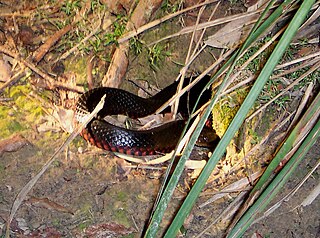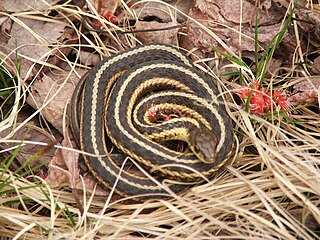
Lieutenant-Colonel Edward Arthur Butler was an English ornithologist and British Army officer. He is commemorated in the scientific specific name for the Omani owl, Strix butleri.

Pseudechis is a genus of venomous snakes in the family Elapidae. It contains the group of elapid species commonly referred to as the black snakes. Species of Pseudechis are found in every Australian state with the exception of Tasmania, and some species are found in Papua New Guinea. They inhabit a variety of habitat types, from arid areas to swampland. All species are dangerous and can inflict a potentially lethal bite. Most snakes in this genus reach about 2 m (6.6 ft) in total length, and vary in colour. Some species are brown, whereas others are black. The most recognisable and widespread species in the genus are the red-bellied black snake and the mulga snake. These snakes feed on lizards, frogs, birds, small mammals, and even other snakes. All species of Pseudechis lay eggs with the exception of the red-bellied black snake P. porphyriacus which is viviparous. The genus Pailsus is a synonym of Pseudechis, and more work is needed to understand species limits among the smaller species of the group.

Butler's garter snake is a species of garter snake in the family Colubridae. The species is endemic to North America.
Dunmall's snake is a species of venomous snake in the family Elapidae. The species is endemic to Australia.
Cyclotyphlops deharvengi, or Deharveng’s blind snake, is a species of blind snake placed in the monotypic genus Cyclotyphlops. It is found in southeastern Sulawesi, Indonesia. No subspecies are currently recognized.
Chilorhinophis is a genus of mildly venomous snakes endemic to Africa. Currently, three species are recognized.
The spotted mulga snake, also known commonly as Butler's black snake and Butler's snake, is a species of venomous snake in the family Elapidae. The species is endemic to Western Australia. It is a member of the genus Pseudechis, dangerously venomous snakes that can intimidate an opponent by raising the head and presenting a hood. This cobra-like threat display is supported by the ability to produce a very large amount of venom.
Chilorhinophis butleri, also known commonly as Butler's black-and-yellow burrowing snake and Butler's two-headed snake, is a species of mildly venomous snake in the family Atractaspididae. The species is endemic to East Africa.

Liotyphlops ternetzii beui is a species of nonvenomous snake in the family Anomalepididae. The species is native to northeastern Argentina, eastern Paraguay, and central-western, southeastern, and southern Brazil; the Reptile Database restricts its range to Brazil. It is locally common in Brazil. It is sometimes known as the pale-headed blindsnake.
Anolis carpenteri, also known commonly as Carpenter's anole or the carpenter anole is a species of lizard in the family Dactyloidae. The species is endemic to Central America.
Kinyongia carpenteri, commonly called Carpenter's chameleon or the helmeted chameleon, is a species of chameleon, a lizard in the family Chamaeleonidae. The species is native to central Africa.
Lycodon butleri, also known commonly as Butler's wolf snake, is a species of snake in the family Colubridae. The species is native to southern Thailand and peninsular Malaysia.

Ctenophorus butlerorum, also known commonly as Butler's dragon, the Shark Bay heath dragon and the Edel heath dragon, is a species of lizard in the family Agamidae. The species is endemic to Australia.

Delma butleri, also known commonly as Butler's legless lizard, Butler's scalyfoot, the spinifex snake-lizard, and the unbanded delma, is a species of lizard in the family Pygopodidae. The species is endemic to Australia.

The Liwale round-snouted worm lizard is a species of amphisbaenian in the family Amphisbaenidae. The species is endemic to Tanzania.
Arthur Lennox Butler was a British naturalist. Born in Karachi, he became a curator of a natural history museum in Kuala Lumpur, Malaysia. He later became the superintendent of a game preserve in Sudan before returning to England. He is commemorated in the scientific names of four species of reptile, a bird, and an amphibian.
Morethia butleri, also known commonly as Butler's Morethia and the woodland Morethia skink, is a species of lizard in the family Scincidae. The species is endemic to Australia.
Notoscincus butleri, also known commonly as Butler's snake-eyed skink, the lined soil-crevice skink, and the lined soil-crevis skink, is a species of lizard in the family Scincidae. The species is endemic to Australia.






